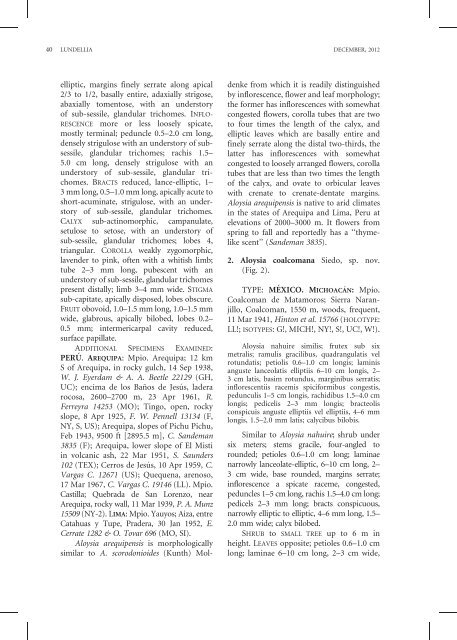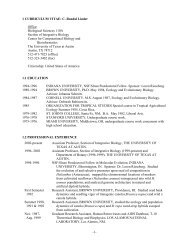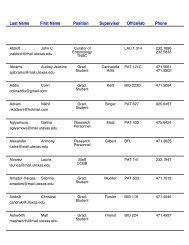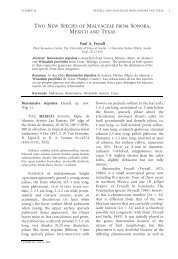FOUR NEW SPECIES OF THE GENUS ALOYSIA (VERBENACEAE)
FOUR NEW SPECIES OF THE GENUS ALOYSIA (VERBENACEAE)
FOUR NEW SPECIES OF THE GENUS ALOYSIA (VERBENACEAE)
Create successful ePaper yourself
Turn your PDF publications into a flip-book with our unique Google optimized e-Paper software.
40 LUNDELLIA DECEMBER, 2012<br />
elliptic, margins finely serrate along apical<br />
2/3 to 1/2, basally entire, adaxially strigose,<br />
abaxially tomentose, with an understory<br />
of sub-sessile, glandular trichomes. INFLO-<br />
RESCENCE more or less loosely spicate,<br />
mostly terminal; peduncle 0.5–2.0 cm long,<br />
densely strigulose with an understory of subsessile,<br />
glandular trichomes; rachis 1.5–<br />
5.0 cm long, densely strigulose with an<br />
understory of sub-sessile, glandular trichomes.<br />
BRACTS reduced, lance-elliptic, 1–<br />
3 mm long, 0.5–1.0 mm long, apically acute to<br />
short-acuminate, strigulose, with an understory<br />
of sub-sessile, glandular trichomes.<br />
CALYX sub-actinomorphic, campanulate,<br />
setulose to setose, with an understory of<br />
sub-sessile, glandular trichomes; lobes 4,<br />
triangular. COROLLA weakly zygomorphic,<br />
lavender to pink, often with a whitish limb;<br />
tube 2–3 mm long, pubescent with an<br />
understory of sub-sessile, glandular trichomes<br />
present distally; limb 3–4 mm wide. STIGMA<br />
sub-capitate, apically disposed, lobes obscure.<br />
FRUIT obovoid, 1.0–1.5 mm long, 1.0–1.5 mm<br />
wide, glabrous, apically bilobed, lobes 0.2–<br />
0.5 mm; intermericarpal cavity reduced,<br />
surface papillate.<br />
ADDITIONAL SPECIMENS EXAMINED:<br />
PERÚ. AREQUIPA: Mpio. Arequipa; 12 km<br />
S of Arequipa, in rocky gulch, 14 Sep 1938,<br />
W. J. Eyerdam & A. A. Beetle 22129 (GH,<br />
UC); encima de los Baños de Jesús, ladera<br />
rocosa, 2600–2700 m, 23 Apr 1961, R.<br />
Ferreyra 14253 (MO); Tingo, open, rocky<br />
slope, 8 Apr 1925, F. W. Pennell 13134 (F,<br />
NY, S, US); Arequipa, slopes of Pichu Pichu,<br />
Feb 1943, 9500 ft [2895.5 m], C. Sandeman<br />
3835 (F); Arequipa, lower slope of El Misti<br />
in volcanic ash, 22 Mar 1951, S. Saunders<br />
102 (TEX); Cerros de Jesús, 10 Apr 1959, C.<br />
Vargas C. 12671 (US); Quequena, arenoso,<br />
17 Mar 1967, C. Vargas C. 19146 (LL). Mpio.<br />
Castilla; Quebrada de San Lorenzo, near<br />
Arequipa,rockywall,11Mar1939,P. A. Munz<br />
15509 (NY-2). LIMA: Mpio. Yauyos; Aiza, entre<br />
Catahuas y Tupe, Pradera, 30 Jan 1952, E.<br />
Cerrate 1282 & O. Tovar 696 (MO, SI).<br />
Aloysia arequipensis is morphologically<br />
similar to A. scorodonioides (Kunth) Mol-<br />
denke from which it is readily distinguished<br />
by inflorescence, flower and leaf morphology;<br />
the former has inflorescences with somewhat<br />
congested flowers, corolla tubes that are two<br />
to four times the length of the calyx, and<br />
elliptic leaves which are basally entire and<br />
finely serrate along the distal two-thirds, the<br />
latter has inflorescences with somewhat<br />
congested to loosely arranged flowers, corolla<br />
tubes that are less than two times the length<br />
of the calyx, and ovate to orbicular leaves<br />
with crenate to crenate-dentate margins.<br />
Aloysia arequipensis is native to arid climates<br />
in the states of Arequipa and Lima, Peru at<br />
elevations of 2000–3000 m. It flowers from<br />
spring to fall and reportedly has a ‘‘thymelike<br />
scent’’ (Sandeman 3835).<br />
2. Aloysia coalcomana Siedo, sp. nov.<br />
(Fig. 2).<br />
TYPE: MÉXICO. MICHOACÁN: Mpio.<br />
Coalcoman de Matamoros; Sierra Naranjillo,<br />
Coalcoman, 1550 m, woods, frequent,<br />
11 Mar 1941, Hinton et al. 15766 (HOLOTYPE:<br />
LL!; ISOTYPES: G!, MICH!, NY!, S!, UC!, W!).<br />
Aloysia nahuire similis; frutex sub six<br />
metralis; ramulis gracilibus, quadrangulatis vel<br />
rotundatis; petiolis 0.6–1.0 cm longis; laminis<br />
anguste lanceolatis elliptiis 6–10 cm longis, 2–<br />
3 cm latis, basim rotundus, marginibus serratis;<br />
inflorescentiis racemis spiciformibus congestis,<br />
pedunculis 1–5 cm longis, rachidibus 1.5–4.0 cm<br />
longis; pedicelis 2–3 mm longis; bracteolis<br />
conspicuis anguste elliptiis vel elliptiis, 4–6 mm<br />
longis, 1.5–2.0 mm latis; calycibus bilobis.<br />
Similar to Aloysia nahuire; shrub under<br />
six meters; stems gracile, four-angled to<br />
rounded; petioles 0.6–1.0 cm long; laminae<br />
narrowly lanceolate-elliptic, 6–10 cm long, 2–<br />
3 cm wide, base rounded, margins serrate;<br />
inflorescence a spicate raceme, congested,<br />
peduncles 1–5 cm long, rachis 1.5–4.0 cm long;<br />
pedicels 2–3 mm long; bracts conspicuous,<br />
narrowly elliptic to elliptic, 4–6 mm long, 1.5–<br />
2.0 mm wide; calyx bilobed.<br />
SHRUB to SMALL TREE up to 6 m in<br />
height. LEAVES opposite; petioles 0.6–1.0 cm<br />
long; laminae 6–10 cm long, 2–3 cm wide,





